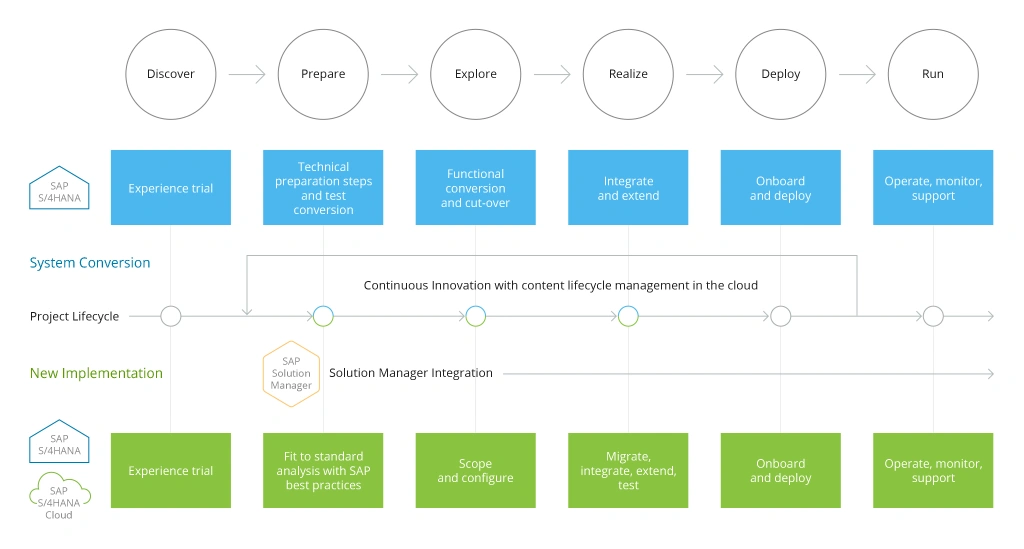Why Do Companies Implement SAP Systems?
It is common when each department has purchased and/or developed its own software solutions and operates independently. Within departments, there may be separate software for specific functions, which is not integrated with the rest of the setup.
According to a recent report, enterprises now use 976 applications on average. Most likely, they lack interconnection and cannot work seamlessly together. So you are not the only one struggling to create a unified business ecosystem that can meet all your current needs.
The report above also shows that only 28% of the applications used by surveyed enterprises are properly integrated with each other. Notably, 38% of the companies consider the lack of integration between siloed business software tools the biggest challenge to digital transformation.
Perhaps it’s time to audit your toolkit and consider a comprehensive ERP solution or a suite of modular apps that will collect and integrate various business operations. Those modular apps can be integrated through the implementation of SAP solutions.
Why Would a Business Want to Implement SAP: One Example
To understand how SAP works and what benefits it can bring, let’s take a product manufacturer as an example.
Within the area of logistics, there are multiple functions: material management, sales and distribution, warehouse management, customer service, and fleet management, to name a few. Each of these functions is usually performed by a separate department that may use own tools for its operation. But how do these departments communicate, so that data is integrated and analyzed to help make sound business decisions?
An SAP solution with all these functions integrated provides the required data and lets stakeholders access it. Once all these features are implemented, it is easier to make decisions that will result in:
- Single integrated platform implementation & TCO reduction for business;
- Applications full support;
- Fewer stock outages and resultant reduction in loss of sales (increased revenue);
- More efficient and reliable materials purchasing with resultant cost-savings and fewer production delays;
- Improved customer satisfaction due to fewer delays in product delivery;
- Reduced distribution and freight costs.
Your business may not be in a manufacturing niche, but there are SAP modules for virtually every business operation. The system’s flexibility and complete integration with those operations result in both efficiency and cost savings at every stage of the product’s lifecycle.
The beauty of SAP software is that companies can implement only the modules a specific business needs in a secure and customizable manner.
What Solutions Does SAP Offer?
Each SAP system module addresses the challenges of specific business operations. While there are also add-on solutions for customization, the standard module package includes:
- Enterprise Resource Planning;
- CRM for Sales and Marketing;
- Sales and Distribution;
- Financial Management;
- Human Resources;
- Asset Management;
- Product Lifecycle Management;
- Supply Chain Management.
SAP provides industry-specific solutions for almost all niches – manufacturing, pharmaceuticals, healthcare, insurance, security, finance, etc. Along with the ability to purchase only those modules that are a “fit”, it translates into two biggest advantages of SAP for businesses of all types and sizes.
Who Uses SAP Solutions?
The latest SAP Corporate Fact Sheet reveals that 99 of the 100 largest global companies use SAP solutions. In total, all SAP customers generate 87% of total global commerce ($46 trillion). While it is often a common belief that only large enterprises implement SAP software, about 80% of its users are small-to-medium sized businesses.
The success of SAP solutions is measured by a company’s bottom line – the result of greater efficiency, better business decisions, and more streamlined operations.
REHAU Group, a German polymers manufacturer, has chosen SAP solutions to digitally transform its Chinese subsidiary REHAU AG China. The initial goal was to implement an intelligent infrastructure for ERP in the cloud and smoothly integrate it with other systems to simplify operations, improve scalability, and reduce operational costs. The SAP benefits for REHAU Group include a 40% lower total cost of ownership, reduced IT costs, and a 50% shorter implementation time with 181 standard processes adopted and rolled out in weeks.
Concepcion Industrial Corporation (CIC), a Philippines-based leader in air-conditioning and refrigeration systems in consumer and business segments, faced a problem with its legacy IT system that could no longer keep up with the company’s digitization and growth pace. They required an up-to-date, intelligent ERP system that would standardize and streamline the operational processes, harmonize data, and improve data analytics capabilities enterprise-wide.
The company chose SAP S/4HANA to integrate systems, automate processes, and unify data across the departments. The chosen solution provides greater simplicity and usability within the SAP Fiori user experience. Such a solution leaves much space for scalability, future growth, and business model changes.
The SAP migration significantly streamlined auditing and enhanced profitability analysis. It also led to more accurate planning and clear visibility into costs and materials. Thanks to the instant financial data access and bank statement upload features, the month-end closing time was reduced by 83% - from 6 hours to less than 1 hour.
If you want to understand why do companies use SAP, these reported stats should provide the full answer.
Implementation of SAP: The Key to Success or Failure
Obviously, once the decision is made to incorporate any of the SAP software solutions, implementation is a process that does not occur overnight. Attempting to implement and deploy too quickly and without expertise is a recipe for failure.
Consider the two different implementations within two related industries – Cadbury, a UK chocolatier, and Hershey, an American candy corporation. Both identified SAP as its solution for a variety of issues – primarily warehouse and inventory issues, logistics, especially distribution to retailers, and generally slow business processes.
Cadbury launched its project for SAP ERP integration over a five-year period, resulting in a new warehouse management system and improved structure of its distribution centers.
While the recommendation for Hershey was a five-year implementation, the company insisted upon 2.5 years, thus compressing the timeline by half. To accomplish this, they sacrificed systems testing and cutover activities. Moreover, they planned the cutover during their busiest season – a huge mistake. As a result, distribution suffered, and Hershey’s reputation declined, resulting in a drop in its stock value.
Implementation is clearly critical. The right expertise must be found, and careful consultation based on company needs and goals must occur before any implementation plan is put into motion.
In general, consider the following implementation phases of the project lifecycle:
Deploying SAP S/4HANA with SAP Activate

SAP Activate is the new methodology for deploying SAP S/4HANA systems. It has inherited certain processes from the older Accelerated SAP and SAP Launch methodologies, but it also contains new accelerators for each implementation phase and work stream. SAP Activate fine-tuned and smoothened the implementation approach for cloud, on-premises, and hybrid deployments – a setup most companies now have. The implementation occurs in the following six phases:
1. Discover
At this stage, you are actively encouraged to investigate the solutions' capabilities; establish the business value and the benefits it can generate for your business. Both C-level executives and managers, along with those responsible for implementation, will have to establish common grounds and develop an adoption plan and roadmap.
SAP allows you to start with a 90-day SAP S/4HANA free trial to explore the solution capabilities and test it in a real environment within your organization. There is also an SAP Community where you can get insights about the SAP system and ask your own questions.
2. Prepare
The prepare stage involves executing the initial planning and getting ready for the implementation process. It is the time you should allocate for finalizing plans, assigning responsible teams, and provisioning the starter system.
Encourage your team to go through a few iterations to fine-tune the project plans and to make sure that those are aligned with respective project activities including:
- Confirmation of project goals;
- High-level scope;
- Clear definition of project roles and responsibilities;
- Strong governance to steer the project lifecycle.
Effective planning is the backbone of the implementation success. Make sure your project plans account for the possible risks that may affect the implementation.
At this stage, you should request the Starter System for the SAP S/4HANA Cloud customers and create user IDs for all the team members. Make sure that your team further completes the onboarding session.
3. Explore
During the exploration stage, you are expected to perform a fit-to-standard analysis to validate the solution functionality listed in the project scope and to confirm that the business requirements can be met.
The Fit-to-Standard analysis is scheduled as a series of workshops with SAP consultants and fosters a productive discussion about validating the predefined scenarios, outlined earlier and exploring additional enhancements/configurations that may be required. Learn more about this stage here.
4. Realize
Once all the scenarios and process requirements are identified, it’s time to deploy a series of Agile sprints to configure, build, and test the new integrated business and system environment. At this point, your team should also start loading the data into the system, outline the adoption activities, and develop cutover plans.
The next activities typically take place during this stage of the project lifecycle:
- Configure the solution in the quality environment using Agile iterations and the backlog created during the exploration phase;
- Make sure that the solution process have been configured to meet your business requirements;
- Execute data migration loads into the quality environment;
- Conduct complete end-to-end testing of the system;
- Integrate the system with other SAP products and legacy systems, if needed;
- Continue with project team implementation of key concepts and system operations;
- Prepare a cutover plan and plan change management;
- Receive quality and production environments.
You can learn more about this stage from SAP’s blog.
5. Deploy
The deployment stage assumes the setup of the production system and confirmation of the company’s readiness to migrate business operations to the new environment. The project manager still remains in charge of crossing out all the tasks from the list and providing risk and issue management.
The key deliverable of this stage is end-user learning and preparation for onboarding. A specific learning plan must be defined. The cutover plan must be in place as well, outlining the key tasks to be performed such as go/no-go decision points, migration/creation of data, and non-transportable object setup. After the cutover execution has been completed, you can set the SAP S/4HANA Cloud system to a Run status. This stage ends with the formal closure of the project.
6. Run
Now it is time to continue the adoption and the implementation of your new solution across the entire company. Start adding new users, encourage them to execute business transactions, and activate additional software functionality if needed. The development team should be running regression testing in the background for the quarterly upgrades to ensure you have the latest version of the system.
A Real SAP HANA Implementation Case by Infopulse
The customer generates reports 90x faster with a centralized Data Warehouse on SAP HANA
Our customer, a Big 4 consulting company (USA), maintained critical business data of numerous BI systems in multiple sources. It slowed down their key business processes, e.g., generating reports took up to 15 hours. Infopulse implemented a centralized 10 TB Data Warehouse on SAP HANA, seamlessly integrated with all of the existing BI systems.
As a result, we helped our customer decrease the time for building reports by 90X (now it takes just up to 10 minutes!), reduced data management and maintenance costs, improved real-time data availability, and simplified its accessibility for over 100,000 employees on a daily basis. On top of that, we developed an ecosystem of BI applications based on the SAP platform to optimize the management of crucial business systems.
Conclusions
The benefits of SAP for business operations are numerous and they can be customized for each business or enterprise.
If you have been asking yourself what SAP software is used for, you now have your answer.
So, what are your business operations needs? How can you see solutions that come from the benefits of SAP?
If you want to explore all your options with SAP, the Infopulse team is ready to consult you and find a perfect fit for your enterprise needs with further implementation. We are international experts in the implementation of SAP solutions for businesses of all sizes and various sectors.
![Why Implement SAP [banner]](https://www.infopulse.com/uploads/media/banner-1920x528-why-do-companies-implement-sap-software.webp)


![Power Apps Licensing Guide [thumbnail]](/uploads/media/thumbnail-280x222-power-apps-licensing-guide.webp)
![Cloud-Native for Banking [thumbnail]](/uploads/media/cloud-native-solutions-for-banking_280x222.webp)
![Generative AI and Power BI [thumbnail]](/uploads/media/thumbnail-280x222-generative-AI-and-Power-BI-a-powerful.webp)
![AI for Risk Assessment in Insurance [thumbnail]](/uploads/media/aI-enabled-risk-assessment_280x222.webp)
![How to Build Enterprise Software Systems [thumbnail]](/uploads/media/thumbnail-280x222-how-to-build-enterprise-software-systems.webp)
![Super Apps Review [thumbnail]](/uploads/media/thumbnail-280x222-introducing-Super-App-a-Better-Approach-to-All-in-One-Experience.webp)
![ServiceNow and Third-Party Integrations [thumbnail]](/uploads/media/thumbnail-280x222-how-to-integrate-service-now-and-third-party-systems.webp)
![SAP Service Insight [thumbnail]](/uploads/media/Service Insight-Infopulse-SAP-Vendor-280x222.webp)
![Carbon Management Challenges and Solutions [thumbnail]](/uploads/media/thumbnail-280x222-carbon-management-3-challenges-and-solutions-to-prepare-for-a-sustainable-future.webp)
![White-label Mobile Banking App [Thumbnail]](/uploads/media/thumbnail-280x222-white-label-mobile-banking-application.webp)